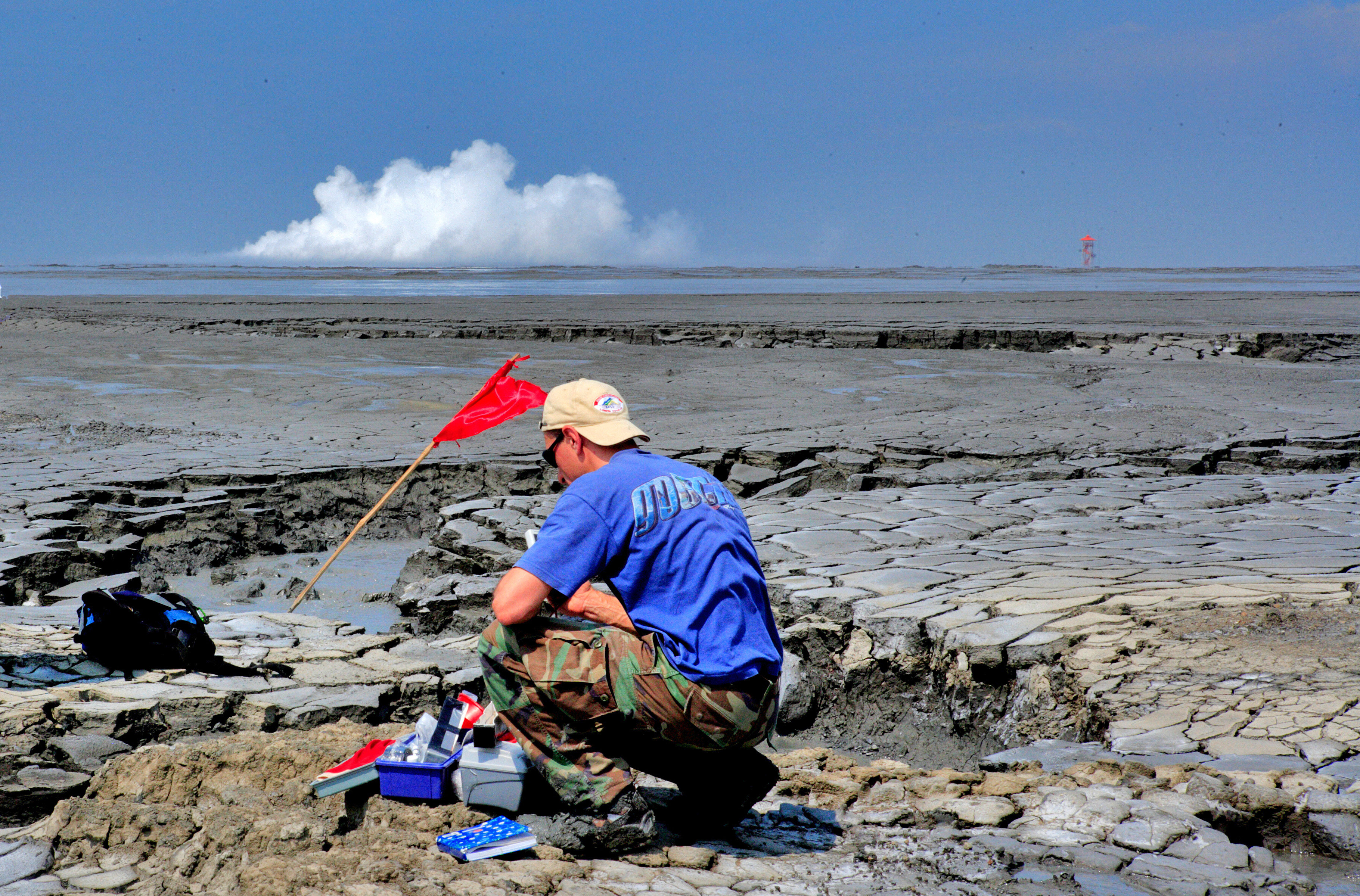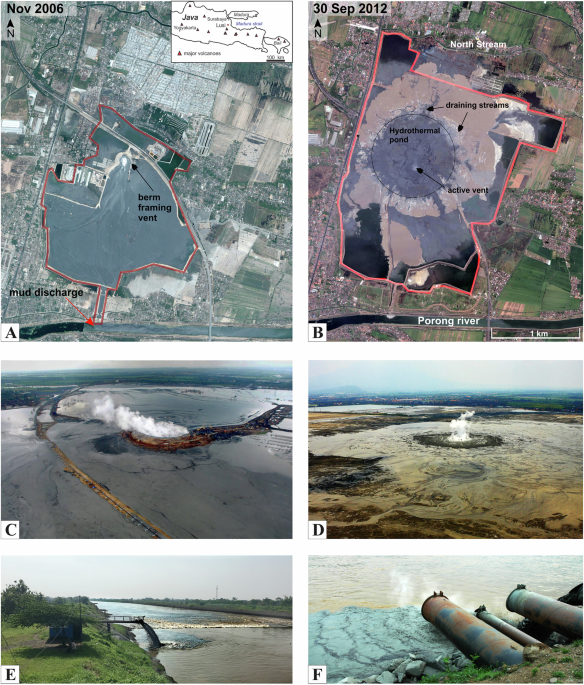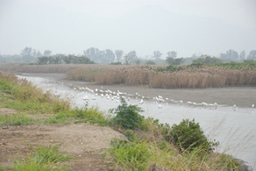The Lusi Mega Seepage Revealed as One of the World’s Largest Natural Oil and Gas Emitters
Published in Earth & Environment
Researchers from the University of Oslo, Norway, and international collaborators have discovered that one of the world’s largest natural manifestations of endogenous fluids, known as Lusi in north-east Java, Indonesia, is releasing vast quantities of oil and gaseous hydrocarbons into the environment—comparable to some of the most significant industrial spills in history.
Lusi is a natural fluid-mud manifestation that geologists classify as “sediment-hosted geothermal system”, since it includes both hot geothermal (CO2 and water vapour) and cold sedimentary (hydrocarbons) fluids. A groundbreaking study led by Dr. Adriano Mazzini from the University of Oslo and published in Communications Earth & Environment reveals that Lusi, active since 2006, is not only the world’s largest active clastic eruption but also a major natural emitter of oil and potent greenhouse and photochemical gases, including methane, ethane, and propane.
The research, conducted by an international team of scientists from Norway, Germany, Italy, the UK, Romania, and Indonesia, presents the first comprehensive quantification of liquid and gaseous hydrocarbon emissions from the Lusi mega seepage system. During the first 13 years of continuous activity, Lusi has released an estimated 0.22–0.28 million tonnes of oil, a volume comparable to the Deepwater Horizon oil spill, in the Gulf of Mexico, one of the largest environmental disasters in recent history.

Drone view of the Lusi eruption and the neighboring Arjuno-Welirang volcanic complex in the background.
Previous studies based on satellite monitoring indicated that Lusi emits about 0.1 mega tonnes of methane per year. The new study reveals that Lusi also emits approximately 8,000–10,000 tonnes of ethane and 6,000–8,000 tonnes of propane annually into the atmosphere making it one of the planet’s largest natural gas emitters. The level of ethane and propane emissions is staggering— over 18 years, Lusi has already injected into the atmosphere more than 20 times the amount of ethane released by the 2015 Aliso Canyon gas storage accident (California), considered as one of largest gas leak in U.S. history.
While methane is a well-known greenhouse gas, ethane and propane are key precursors to tropospheric ozone, a harmful air pollutant and short-lived climate forcer. The study highlights that Lusi’s emissions of these gases are orders of magnitude higher than those from major anthropogenic sources such as the Barnett Shale in Texas or the La Brea Tar Pits in California.
“Our findings show that Lusi is not only a spectacular geological phenomenon, but also a major natural source of hydrocarbons to the atmosphere and aquatic environment,” says Dr. Adriano Mazzini, lead author of this research from the Department of Geosciences at the University of Oslo. “This research confirms that natural seepage is not a minor contributor to atmospheric hydrocarbon budgets. Lusi exemplifies how sediment-hosted geothermal systems can act as powerful, persistent sources of climate-active gases.”

Adriano Mazzini sampling fluid at the Lusi mud eruption, Indonesia. A geysering phase at the crater site is visible in the background.
A natural laboratory of global significance
The Lusi mega seepage system in East Java, Indonesia, has been active for nearly 20 years. Formed through the interaction between an active hydrothermal and petroleum systems, it continuously spews mud, rock clasts, water, gas, and oil to the surface.
This ongoing eruption has become a unique natural laboratory, allowing scientists to study in real time how geological, geochemical, and geothermal processes interact. Dr. Adriano Mazzini conducted dozens of multidisciplinary studies also with a dedicated ERC project to investigate the Lusi plumbing system and the dynamics of fluid migration, sediment transport, and gas emissions.
“Lusi represents and unprecedented opportunity to observe a complex geological system in action,” explains Mazzini, who has been monitoring the eruption since its onset in 2006 and conducting annual field expeditions leading geochemical. geophysical and onsite monitoring surveys. “Each year, we gain new insights into how magmatic heat and organic-rich sediments interact to produce such large-scale hydrocarbon emissions.”
Environmental and global implications
The oil- and gas-charged mud from Lusi drains into the Porong River and the Madura Strait, posing ongoing environmental challenges for aquatic ecosystems in northeast Java. The authors highlight the urgent need for monitoring oil contamination in riverine and coastal sediments, as well as assessing long-term ecological impacts.
The findings also contribute to a broader understanding of natural contributions to greenhouse gas and hydrocarbon emissions, helping distinguish them from human-induced sources.
“Understanding the full spectrum of hydrocarbon emissions—both anthropogenic and natural—is essential for an accurate evaluation of the atmospheric greenhouse gas budget and the effectiveness of mitigation strategies to reduce man-made sources, considering that the natural ones cannot be controlled,” added Giuseppe Etiope, from the Istituto Nazionale di Geofisica a Vulcanologia in Italy, co-author of the work. “Lusi provides a unique natural laboratory to investigate these processes in real time.”
An international collaboration
The paper, titled “Extensive oil, ethane and propane discharge at the mega seepage system of Lusi, Indonesia”, is available in Communications Earth & Environment, a journal from Nature Portfolio. This research combines over a decade of field measurements, geochemical analyses, and satellite data to provide an unprecedented look into the scale and impact of natural hydrocarbon seepage. The study was conducted by researchers from:
- University of Oslo and Institute for Energy Technology (Norway),
- Istituto Nazionale di Geofisica e Vulcanologia (Italy),
- Federal Institute for Geosciences and Natural Resources (Germany),
- Integrated Geochemical Interpretation Ltd (UK),
- Pusat Pengendalian Lumpur Sidoarjo (PPLS) (Indonesia), and
- Babeș-Bolyai University (Romania).
Their work sheds new light on how geological and magmatic processes shape the Earth’s natural emissions and highlights Lusi as one of the most remarkable and scientifically valuable seepage systems on the planet.
Follow the Topic
-
Communications Earth & Environment

An open access journal from Nature Portfolio that publishes high-quality research, reviews and commentary in the Earth, environmental and planetary sciences.
Related Collections
With Collections, you can get published faster and increase your visibility.
Geology of the Moon
Publishing Model: Hybrid
Deadline: Jan 31, 2026
Drought
Publishing Model: Hybrid
Deadline: Dec 31, 2025




Please sign in or register for FREE
If you are a registered user on Research Communities by Springer Nature, please sign in